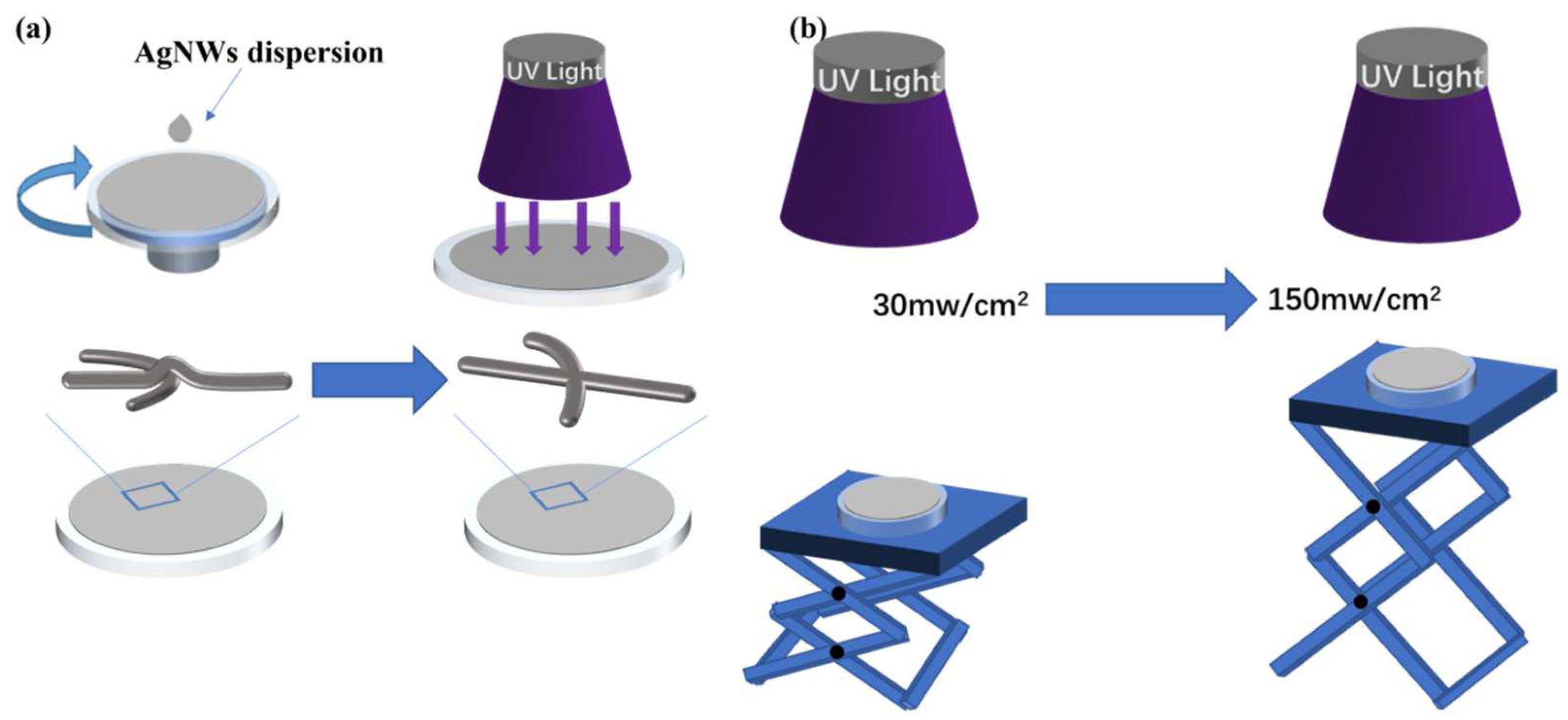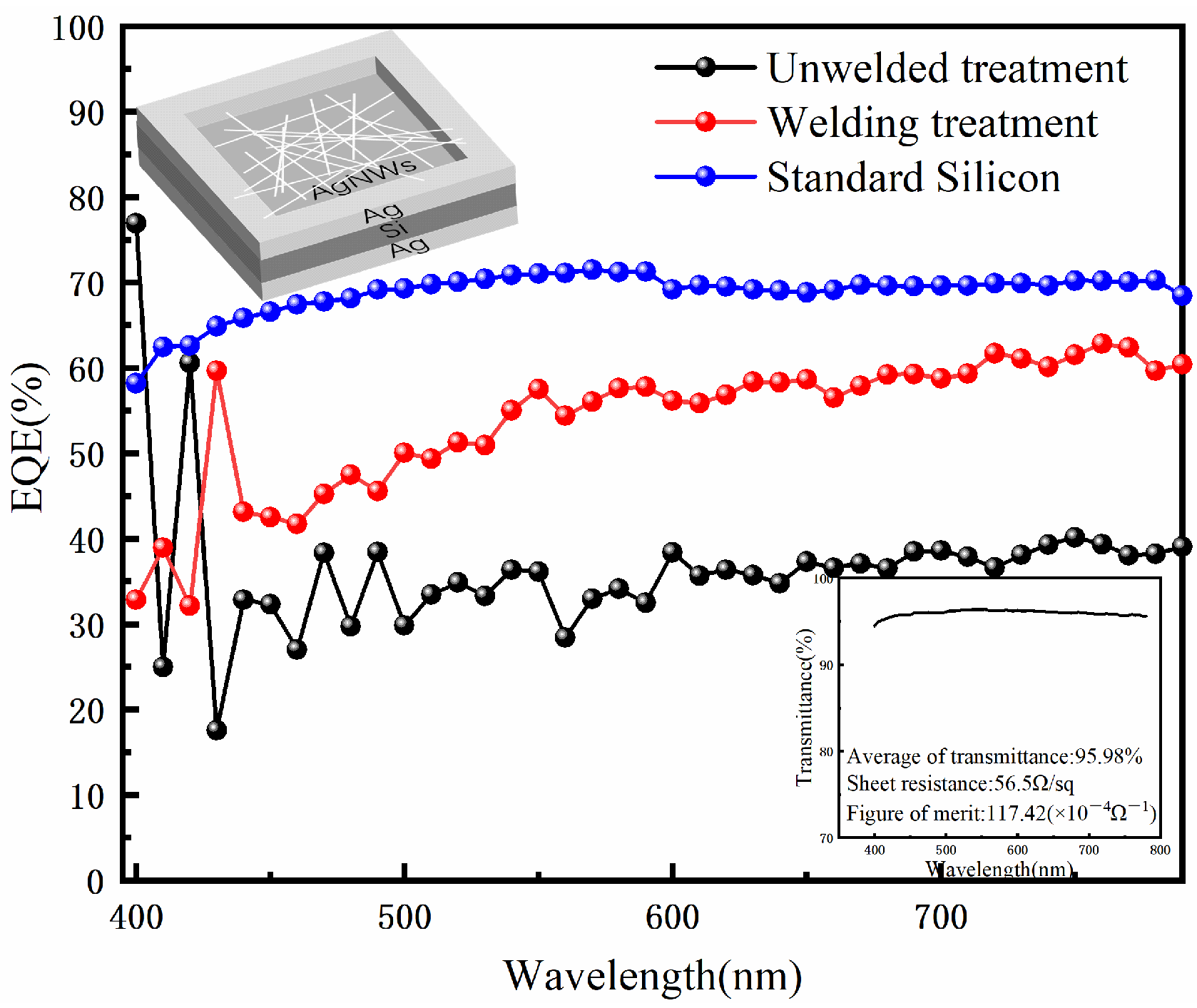Performance Enhancement of Silver Nanowire-Based Transparent Electrodes by Ultraviolet Irradiation
Abstract
:1. Introduction
2. Materials and Methods
2.1. Preparation of the AgNWs
2.2. UV Irradiation Welding of AgNWs
2.3. Characterization
3. Results and Discussion
3.1. Optical Properties
3.2. Electrical Properties
3.3. Figure of Merit
3.4. Microstructural Properties
3.5. The Device Application
4. Conclusions
Author Contributions
Funding
Institutional Review Board Statement
Informed Consent Statement
Data Availability Statement
Acknowledgments
Conflicts of Interest
References
- Liu, Y.; Zhang, J.; Gao, H.; Wang, Y.; Liu, Q.; Huang, S.; Guo, C.F.; Ren, Z. Capillary-Force-Induced Cold Welding in Silver-Nanowire-Based Flexible Transparent Electrodes. Nano Lett. 2017, 17, 1090–1096. [Google Scholar] [CrossRef] [PubMed]
- Liang, X.; Zhao, T.; Zhu, P.; Hu, Y.; Sun, R.; Wong, C.-P. Room-Temperature Nanowelding of a Silver Nanowire Network Triggered by Hydrogen Chloride Vapor for Flexible Transparent Conductive Films. ACS Appl. Mater. Interfaces 2017, 9, 40857–40867. [Google Scholar] [CrossRef] [PubMed]
- Kiristi, M.; Gulec, A.; Bozduman, F.; Oksuz, L.; Oksuz, A.U.; Hala, A. Radio Frequency-H2O Plasma Treatment on Indium Tin Oxide Films Produced by Electron Beam and Radio Frequency Magnetron Sputtering Methods. Thin Solid Films 2014, 567, 32–37. [Google Scholar] [CrossRef]
- He, W.; Ye, C. Flexible Transparent Conductive Films on the Basis of Ag Nanowires: Design and Applications: A Review. J. Mater. Sci. Technol. 2015, 31, 581–588. [Google Scholar] [CrossRef]
- Lin, Y.; Li, Q.; Ding, C.; Wang, J.; Yuan, W.; Liu, Z.; Su, W.; Cui, Z. High-Resolution and Large-Size Stretchable Electrodes Based on Patterned Silver Nanowires Composites. Nano Res. 2022, 15, 4590–4598. [Google Scholar] [CrossRef]
- Hecht, D.S.; Hu, L.; Irvin, G. Emerging Transparent Electrodes Based on Thin Films of Carbon Nanotubes, Graphene, and Metallic Nanostructures. Adv. Mater. 2011, 23, 1482–1513. [Google Scholar] [CrossRef]
- Kim, K.S.; Zhao, Y.; Jang, H.; Lee, S.Y.; Kim, J.M.; Kim, K.S.; Ahn, J.-H.; Kim, P.; Choi, J.-Y.; Hong, B.H. Large-Scale Pattern Growth of Graphene Films for Stretchable Transparent Electrodes. Nature 2009, 457, 706–710. [Google Scholar] [CrossRef]
- Pirlot, P.; Bernier, R. Brain Growth and Differentiation in Two Fetal Bats: Qualitative and Quantitative Aspects. Am. J. Anat. 1991, 190, 167–181. [Google Scholar] [CrossRef]
- De, S.; Higgins, T.M.; Lyons, P.E.; Doherty, E.M.; Nirmalraj, P.N.; Blau, W.J.; Boland, J.J.; Coleman, J.N. Silver Nanowire Networks as Flexible, Transparent, Conducting Films: Extremely High DC to Optical Conductivity Ratios. ACS Nano 2009, 3, 1767–1774. [Google Scholar] [CrossRef]
- Hu, L.; Wu, H.; Cui, Y. Metal Nanogrids, Nanowires, and Nanofibers for Transparent Electrodes. MRS Bull. 2011, 36, 760–765. [Google Scholar] [CrossRef] [Green Version]
- Hu, L.; Kim, H.S.; Lee, J.-Y.; Peumans, P.; Cui, Y. Scalable Coating and Properties of Transparent, Flexible, Silver Nanowire Electrodes. ACS Nano 2010, 4, 2955–2963. [Google Scholar] [CrossRef] [PubMed]
- Lee, J.-Y.; Connor, S.T.; Cui, Y.; Peumans, P. Solution-Processed Metal Nanowire Mesh Transparent Electrodes. Nano Lett. 2008, 8, 689–692. [Google Scholar] [CrossRef] [PubMed]
- Wu, J.; Que, X.; Hu, Q.; Luo, D.; Liu, T.; Liu, F.; Russell, T.P.; Zhu, R.; Gong, Q. Multi-Length Scaled Silver Nanowire Grid for Application in Efficient Organic Solar Cells. Adv. Funct. Mater. 2016, 26, 4822–4828. [Google Scholar] [CrossRef]
- Ye, N.; Yan, J.; Xie, S.; Kong, Y.; Liang, T.; Chen, H.; Xu, M. Silver Nanowire–Graphene Hybrid Transparent Conductive Electrodes for Highly Efficient Inverted Organic Solar Cells. Nanotechnology 2017, 28, 305402. [Google Scholar] [CrossRef]
- Wang, S.; Liu, H.; Pan, Y.; Bai, M.; Xie, F.; Zhao, J.; Xue, K.; Wen, S.; Chen, P. Demonstration of Wide Spectrum Transparent Conductive Composite Films Based on Silver Nanowires and Graphene. Infrared Phys. Technol. 2022, 124, 104172. [Google Scholar] [CrossRef]
- Kang, H.; Kim, Y.; Cheon, S.; Yi, G.-R.; Cho, J.H. Halide Welding for Silver Nanowire Network Electrode. ACS Appl. Mater. Interfaces 2017, 9, 30779–30785. [Google Scholar] [CrossRef]
- Song, T.-B.; Chen, Y.; Chung, C.-H.; Yang, Y.; Bob, B.; Duan, H.-S.; Li, G.; Tu, K.-N.; Huang, Y.; Yang, Y. Nanoscale Joule Heating and Electromigration Enhanced Ripening of Silver Nanowire Contacts. ACS Nano 2014, 8, 2804–2811. [Google Scholar] [CrossRef]
- Garnett, E.C.; Cai, W.; Cha, J.J.; Mahmood, F.; Connor, S.T.; Greyson Christoforo, M.; Cui, Y.; McGehee, M.D.; Brongersma, M.L. Self-Limited Plasmonic Welding of Silver Nanowire Junctions. Nat. Mater. 2012, 11, 241–249. [Google Scholar] [CrossRef]
- Park, J.H.; Hwang, G.-T.; Kim, S.; Seo, J.; Park, H.-J.; Yu, K.; Kim, T.-S.; Lee, K.J. Flash-Induced Self-Limited Plasmonic Welding of Silver Nanowire Network for Transparent Flexible Energy Harvester. Adv. Mater. 2017, 29, 1603473. [Google Scholar] [CrossRef]
- Yoon, S.-S.; Khang, D.-Y. Room-Temperature Chemical Welding and Sintering of Metallic Nanostructures by Capillary Condensation. Nano Lett. 2016, 16, 3550–3556. [Google Scholar] [CrossRef]
- Chang, Y.-M.; Yeh, W.-Y.; Chen, P.-C. Highly Foldable Transparent Conductive Films Composed of Silver Nanowire Junctions Prepared by Chemical Metal Reduction. Nanotechnology 2014, 25, 285601. [Google Scholar] [CrossRef] [PubMed]
- Lu, H.; Zhang, D.; Cheng, J.; Liu, J.; Mao, J.; Choy, W.C.H. Locally Welded Silver Nano-Network Transparent Electrodes with High Operational Stability by a Simple Alcohol-Based Chemical Approach. Adv. Funct. Mater. 2015, 25, 4211–4218. [Google Scholar] [CrossRef]
- Liang, X.; Lu, J.; Zhao, T.; Yu, X.; Jiang, Q.; Hu, Y.; Zhu, P.; Sun, R.; Wong, C. Facile and Efficient Welding of Silver Nanowires Based on UVA-Induced Nanoscale Photothermal Process for Roll-to-Roll Manufacturing of High-Performance Transparent Conducting Films. Adv. Mater. Interfaces 2018, 6, 1801635. [Google Scholar] [CrossRef]
- Kou, P.; Yang, L.; Chang, C.; He, S. Improved Flexible Transparent Conductive Electrodes Based on Silver Nanowire Networks by a Simple Sunlight Illumination Approach. Sci. Rep. 2017, 7, 42052. [Google Scholar] [CrossRef]
- Sun, Y.; Gates, B.; Mayers, B.; Xia, Y. Crystalline Silver Nanowires by Soft Solution Processing. Nano Lett. 2002, 2, 165–168. [Google Scholar] [CrossRef]
- Sun, Y.; Yin, Y.; Mayers, B.T.; Herricks, T.; Xia, Y. Uniform Silver Nanowires Synthesis by Reducing AgNO3 with Ethylene Glycol in the Presence of Seeds and Poly (Vinyl Pyrrolidone). Chem. Mater. 2002, 14, 4736–4745. [Google Scholar] [CrossRef]
- Guan, P.; Zhu, R.; Zhu, Y.; Chen, F.; Wan, T.; Xu, Z.; Joshi, R.; Han, Z.; Hu, L.; Wu, T.; et al. Performance Degradation and Mit-igation Strategies of Silver Nanowire Networks. Crit. Rev. Solid State Mater. Sci. 2022, 47, 435–459. [Google Scholar] [CrossRef]
- Wang, J.; Jiu, J.; Zhang, S.; Sugahara, T.; Nagao, S.; Suganuma, K.; He, P. The Comprehensive Effects of Visible Light Irradition on Silver Nanowire Transparent Electrode. Nanotechnology 2018, 29, 435701. [Google Scholar] [CrossRef]
- Haacke, G. New Figure of Merit for Transparent Conductors. J. Appl. Phys. 1976, 47, 4086–4089. [Google Scholar] [CrossRef]
- Li, H.; Gao, Y.-J.; Yuan, S.-H.; Wuu, D.-S.; Wu, W.-Y.; Zhang, S. Improvement in the Figure of Merit of ITO-Metal-ITO Sandwiched Films on Poly Substrate by High-Power Impulse Magnetron Sputtering. Coatings 2021, 11, 144. [Google Scholar] [CrossRef]
- Zhao, J.; Liu, H.; Deng, L.; Bai, M.; Xie, F.; Wen, S.; Liu, W. High Quantum Efficiency and Broadband Photodetector Based on Graphene/Silicon Nanometer Truncated Cone Arrays. Sensors 2021, 21, 6146. [Google Scholar] [CrossRef] [PubMed]
- Choi, J.; Shim, Y.S.; Park, C.H.; Hwang, H.; Kwack, J.H.; Lee, D.J.; Park, Y.W.; Ju, B.-K. Junction-Free Electrospun Ag Fiber Electrodes for Flexible Organic Light-Emitting Diodes. Small 2018, 14, 1702567. [Google Scholar] [CrossRef] [PubMed]
- Kim, H.-S.; Patel, M.; Kim, H.; Kim, J.-Y.; Kwon, M.-K.; Kim, J. Solution-Processed Transparent Conducting Ag Nanowires Layer for Photoelectric Device Applications. Mater. Lett. 2015, 160, 305–308. [Google Scholar] [CrossRef]
- Luo, Y.; Wang, J.; Wang, P.; Mai, C.; Wang, J.; Yap, B.K.; Peng, J. Effects of UV Irradiation and Storage on the Performance of Inverted Red Quantum-Dot Light-Emitting Diodes. Nanomaterials 2021, 11, 1606. [Google Scholar] [CrossRef] [PubMed]
- Aristidou, N.; Sanchez-Molina, I.; Chotchuangchutchaval, T.; Brown, M.; Martinez, L.; Rath, T.; Haque, S.A. The Role of Oxygen in the Degradation of Methylammonium Lead Trihalide Perovskite Photoactive Layers. Angew. Chem. Int. Ed. 2015, 54, 8208–8212. [Google Scholar] [CrossRef]
- Nan, G.; Zhang, X.; Lu, G. Self-Healing of Photocurrent Degradation in Perovskite Solar Cells: The Role of Defect-Trapped Excitons. J. Phys. Chem. Lett. 2019, 10, 7774–7780. [Google Scholar] [CrossRef] [PubMed]







| Influence Factor | 30 mw | 60 mw | 90 mw | 120 mw | 150 mw | - | |
| Optical power density | Before irradiation(Rs0)/Ω·sq−1 | 98.5928 | 114.323 | 107.0665 | 101.30134 | 112.1804 | - |
| After irradiation(Rs)/Ω·sq−1 | 88.369775 | 84.4353 | 87.34624 | 129.2432 | 170.1116 | - | |
| Rs/RS0 | 0.8963 | 0.7386 | 0.8158 | 1.2758 | 1.5164 | - | |
| Influence Factor | 1 min | 2 min | 3 min | 4 min | 5 min | 6 min | |
| Irradiation time | Before irradiation(Rs0)/Ω·sq−1 | 114.323 | 126.213 | 128.354 | 122.7258 | 106.1785 | 124.06775 |
| After irradiation(Rs)/Ω·sq−1 | 89.77218 | 77.87644 | 73.54312 | 72.39732 | 69.75925 | 72.6567 | |
| Rs/RS0 | 0.79905 | 0.64003 | 0.56596 | 0.59091 | 0.6036 | 0.57137 | |
| Influence Factor | 350 nm | 360 nm | 370 nm | 380 nm | 390 nm | 400 nm | |
| Ultraviolet wavelength | Before irradiation(Rs0)/Ω·sq−1 | 123.2068 | 114.678 | 113.164 | 128.354 | 109.01 | 117.949 |
| After irradiation(Rs)/Ω·sq−1 | 88.8007 | 81.857 | 77.8225 | 73.54312 | 92.6678 | 99.147 | |
| Rs/RS0 | 0.7207 | 0.7138 | 0.6877 | 0.57297 | 0.85 | 0.8406 |
Publisher’s Note: MDPI stays neutral with regard to jurisdictional claims in published maps and institutional affiliations. |
© 2022 by the authors. Licensee MDPI, Basel, Switzerland. This article is an open access article distributed under the terms and conditions of the Creative Commons Attribution (CC BY) license (https://creativecommons.org/licenses/by/4.0/).
Share and Cite
Wang, S.; Liu, H.; Pan, Y.; Xie, F.; Zhang, Y.; Zhao, J.; Wen, S.; Gao, F. Performance Enhancement of Silver Nanowire-Based Transparent Electrodes by Ultraviolet Irradiation. Nanomaterials 2022, 12, 2956. https://doi.org/10.3390/nano12172956
Wang S, Liu H, Pan Y, Xie F, Zhang Y, Zhao J, Wen S, Gao F. Performance Enhancement of Silver Nanowire-Based Transparent Electrodes by Ultraviolet Irradiation. Nanomaterials. 2022; 12(17):2956. https://doi.org/10.3390/nano12172956
Chicago/Turabian StyleWang, Shengyong, Huan Liu, Yongqiang Pan, Fei Xie, Yan Zhang, Jijie Zhao, Shuai Wen, and Fei Gao. 2022. "Performance Enhancement of Silver Nanowire-Based Transparent Electrodes by Ultraviolet Irradiation" Nanomaterials 12, no. 17: 2956. https://doi.org/10.3390/nano12172956
APA StyleWang, S., Liu, H., Pan, Y., Xie, F., Zhang, Y., Zhao, J., Wen, S., & Gao, F. (2022). Performance Enhancement of Silver Nanowire-Based Transparent Electrodes by Ultraviolet Irradiation. Nanomaterials, 12(17), 2956. https://doi.org/10.3390/nano12172956







